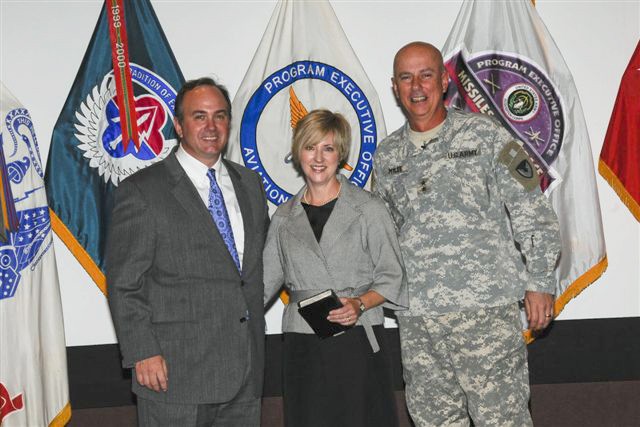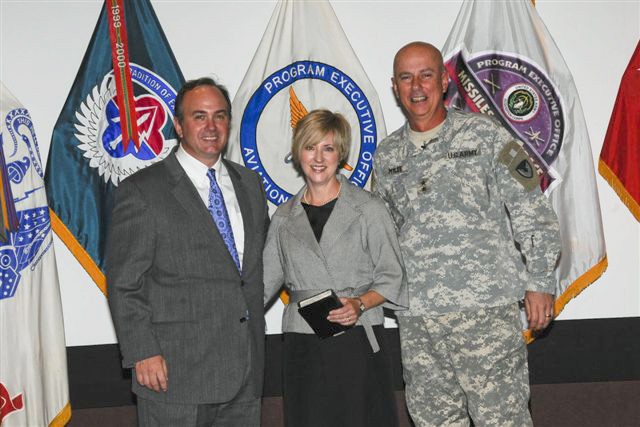
Family, friends, colleagues, and fellow members of Team Redstone gathered in the Bob Jones Auditorium to share in the experience and bear witness as C. Stephen Cornelius, Associate Director for Missile Development, Aviation and Missile Research Development, and Engineering Center was sworn in as a member of the Senior Executive Service.
The Senior Executive Service is comprised of the men and women charged with leading the continuing transformation of our government. This dedicated corps of executives shares a commitment to public service and a set of democratic values grounded in the fundamental ideals of the Constitution. As the leaders of our Federal civilian workforce, Senior Executives strive each day to create a more citizen centered, result oriented Federal Government.
Maj. Gen. James Myles, Commanding General, Aviation and Missile Life Cycle Management Command, who officiated the ceremony, spoke of Cornelius' selection to the SES, and his dedication to Team Redstone and, most important, to the Soldier.
"We got it right with this guy. I've been doing this thing in the Army for about 34 years and every once in a while I know what right looks like. It's about building a team and being able to make things better. It's about what we can do for others. This guy is made of gold. His heart is huge. These are the type of people we want to sustain the great workforce that we have now and actually take it to the next level," said Myles.
In his current position Cornelius leads the strategic planning for technology programs and executes efforts directed towards the development of materiel for new or improved Army guided weapons, missiles, free rockets, directed energy weapons, and associated supporting technologies including aero-thermo chemistry, guidance and control sensors and seekers launchers and propulsion and modeling and simulation.
"It's not about how smart you are it's not about the technology and the engineering that you have-you must have that to do what you have to do in this business especially if you are an SES, an SES inside of AMRDEC. What it does require that brings you to the next level that has made this guy a no-brainer to come step forward to become an SES is this guy's heart; this guy's leadership," said Myles.
After taking the oath, Cornelius paid tribute to his roots, those who went before him and those who continue to serve the Nation and its Warfighters.
"If you take time and look around this arsenal you cannot help but being in awe of the fundamental and groundbreaking work that was done here. Some of you in this audience were here from the very beginning when the pioneering and engineering and science work of the United States army paved the way not only for the development of extremely precise and effective weapons but also led the United States in the peaceful exploration of space.
"Since those early days the words 'Huntsville', 'Redstone,' and 'missile' have been forever and inextricably linked. We have played a part in making the United States Army the most feared, the most adaptable, the most survivable, the most respected, and the most capable Army in the world-of all times. I am proud to be a small part of that ongoing legacy here at Redstone," Cornelius said.
Looking to the future, Cornelius spoke of mission, challenges, and mentoring the workforce as he was once mentored.
"The missile and the related technologies that were developed here on this post and across the country with our industry partners have provided our political leaders and our commanders in the field the ability to effectively promote and protect this our nation's interests abroad.
"There are very serious challenges ahead of us to ensure that this important research continues because it has been one of the mainstays of our United States Army and this town for several decades," said Cornelius.
Dr. William McCorkle, Executive Director of the AMRDEC, specifically addressed two of many challenges Cornelius and the AMRDEC will face in the future.
"We've been involved for some time with the Future Combat System. The challenge is to produce missile armament systems for vehicles that are very lightweight or that cannot be as heavy as necessary to withstand fire from other armored vehicles. So we have the job of providing the direct fire kinetic energy system and this is one of Steve's main achievements, his great contributions, to the Compact Kinetic Energy Missile that we demonstrated so well. It is a distinction that it can damage or destroy any armored system that is known to be in service and probably more," said McCorkle.
McCorkle went on to discuss the Non-Line of Site System of NLOS as being another challenge.
"We also have to be able to fire from a non-line-of-sight system because we want to make sure that we protect the systems that we have by taking advantage of defilade. The secret is supposed to be a network of sensors that would be so good and the exquisitely good situational awareness that we would receive from these sensors. I have every confidence that Steve will make major contributions to that in his future service," McCorkle said.
As a native of Huntsville, Cornelius and his family lived the legacy of Huntsville-the Rocket City. His father was a NASA Engineer for 36 years and he remembers coming to work with his father on visiting days and seeing all of the rockets and missiles on Redstone Arsenal.
"Growing up in Huntsville in the 60s and the 70's was a unique experience. Everyone in town seemed to work for the NASA or the Army. They were all engineers, scientists, or technicians working in that exciting time. I truly thought that that was 'normal'. When I went to college I found out that not everybody in the country does what my parents and my parents' friends and all of you do for a living. It was quite shocking," said Cornelius.
What was shocking to Cornelius was what he took for granted as being normal and ordinary were indeed rocket science and high-tech; he lived with and among people who were changing the world.
"Only in college did I develop the deep appreciation for the intellect, passion, and extraordinary genius of the people who I grew up with. People that were friends of my parents, my baseball coaches, my football coaches, my friends at church - these regular people were in fact at this time profoundly changing this country and all the while leading their regular lives. I owe those teachers, coaches, family friends much but the depth of the gratitude to my parents cannot be measured," Cornelius said.
Fresh from college, he graduated from the University of Alabama on May 17 and began working for the US Army Missile Command two days later, Cornelius was given great responsibility, lots of hands-on work, and the opportunity to use his knowledge.
Two of individuals who stand out in his professional are Mike Schexnayder, former Deputy Commander for Research, Development and Acquisition at the US Army Space and Missile Defense Command/Army Strategic Command and Dr. Michael Lyon, former Director of the AMRDEC's Propulsion and Structures Directorate.
"Working for Mike Schexnayder in the Warheads Group that first year, I was taking TOW missiles apart, designing parts, integrating new warheads, new sensors, new wings, building them in at TA-2, and then going out and flying them on the range. Within a year of graduation, I was flying missiles that I had built.
"It was incredible. I would have never dreamed that I would be doing that kind of work a year before. I was using my engineering, I was doing stress analysis, I was doing dynamics. I think it was very unique to be able to go do that right out of school," said Cornelius.
Schexnayder pushed Cornelius and others to go outside of their comfort zone, to do things they wouldn't normally do, and experience the gamut of their field inside and outside of the organization.
Schexnayder gave them all a lot of responsibility early and a lot of authority to operate. He believed that the ideas of young engineers, scientists, and technicians were as important as those with much more experience.
"It made a big difference to me and my motivation that my ideas were considered," said Cornelius.
Many years later, Cornelius was given the opportunity to lead the Propulsion and Structures Directorate when the current Director, Dr. Michael Lyon, was moved to the front office.
"Mike Lyon was very influential to me by letting me do his job when he wasn't there. Mike gave me full authority to make changes, plot a new direction if I needed to and that meant a lot to me. It was incredible and one of my favorite jobs I ever had," said Cornelius.
Cornelius started work on Redstone Arsenal during the Cold War and though many aspects of the Army have changed the one thing that remains constant is the dedication to the Soldier. This is how he measures personal and organizational success.
"Success for me is being able to continue to support the ongoing fight now; make sure that those guys and gals have the best of whatever they need whether it be missiles or upgrades to missiles - that is success.
There are things coming down the pike that we have to be ready for. We have to pay close attention to what the enemy has learned and what they will do next so we can counter it. We have to continually bring in new resources and new people to be ready for the future," said Cornelius.
One adaptation to the current fight was the development and fielding of the Guided Multiple Launch Rocket System.
"We are building on legacy systems, making them better, more adapted to this type of war. Guided MLRS came out of the lab, was fielded and has become an incredible weapon for the long range engagement of enemy forces in depth but also precise engagements in urban terrain. It was a fundamental change in how you fight, and how that branch fights that type weapon," said Cornelius.
Everyday is a balancing act, making sacrifices, and taking care of family. Ultimately, the job, more often than not, comes first and this is something his family endures because they too live the legacy of service to the Nation.
"All of us share an awesome responsibility; we must strive everyday to provide the very best equipment, weapons platforms, and support to our great Soldiers. There is no room for failure or good enough.
We are part of a bigger whole; we try to help the future Warfighter. We have to balance that. The current fight takes precedence, in all cases. But we cannot lose the focus for the future because it takes a long time to get technologies ready to be put into the system and be used safely and effectively," said Cornelius.

Social Sharing